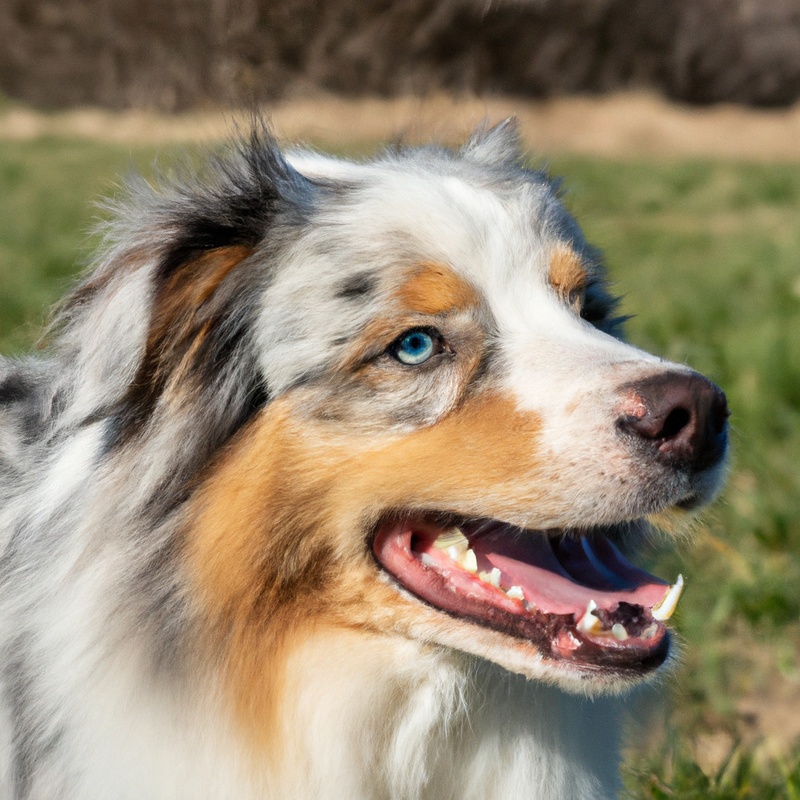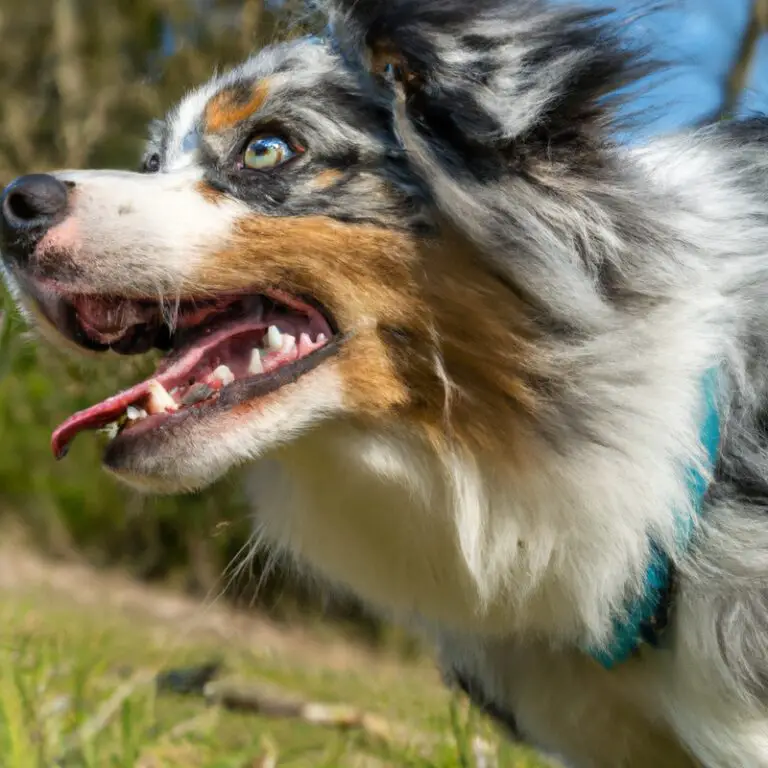How Do Australian Shepherds Behave Around Cats?
Key Takeaways:
- 1) Australian Shepherds generally have a friendly and adaptable nature towards cats.
- 2) Proper socialization and training are crucial for fostering a positive relationship between Australian Shepherds and cats.
- 3) Early exposure and gradual introductions can help Australian Shepherds and cats establish a harmonious bond.
- 4) It is important to supervise interactions between Australian Shepherds and cats to ensure their safety and prevent any potential conflicts.
Are you a cat lover considering bringing an Australian Shepherd into your home? Or perhaps you already have both and are wondering how these two furry companions will get along?
Well, you’ve come to the right place! As an experienced dog owner and enthusiast, I’ve seen firsthand how Australian Shepherds behave around cats.
These intelligent and energetic canines have unique breed characteristics and temperaments that influence their interactions with our feline friends. In this article, we’ll explore the behavior of Australian Shepherds around cats, strategies for successful introductions, and tips for maintaining a harmonious and happy coexistence.
Let’s dive in!
| Australian Shepherds | Cats |
|---|---|
| Intelligent and adaptable | Sensitive and independent |
| Responsive to training | Familiar with dogs |
| Active and energetic | Curious and playful |
| Herding instincts | Territorial tendencies |
| May chase cats | May feel threatened by dogs |
| Can be compatible with cats with proper socialization | May take time to adjust to coexisting with dogs |
Understanding Australian Shepherds
Overview of Australian Shepherd breed characteristics
Australian Shepherds are known for their intelligence, agility, and loyalty. They are medium-sized dogs with a well-muscled body and a thick double coat that comes in various colors.
These dogs are highly active and require regular exercise and mental stimulation to keep them happy and healthy.
Australian Shepherds are highly trainable and excel in various dog sports and activities such as obedience, agility, and herding trials. They have a strong herding instinct and may try to herd children, pets, or even objects if not properly directed.
While Australian Shepherds are generally friendly and affectionate, they can be reserved or aloof around strangers.
This makes them excellent watchdogs, as they are alert and protective of their family. However, early socialization is important to ensure they are well-rounded and comfortable around different people and environments.
Temperament of Australian Shepherds
The temperament of Australian Shepherds is known for being intelligent, active, and loyal. These dogs are highly trainable, making them great companions for those willing to put in the time and effort.
They are generally friendly and social towards both humans and other animals, including cats.
However, it’s important to note that individual personalities can vary. Some Australian Shepherds may have a stronger prey drive and exhibit more intense herding instincts than others.
Early socialization and training are key in shaping their behavior and ensuring they get along well with cats and other pets.
Remember to provide plenty of mental and physical stimulation to keep your Australian Shepherd happy and fulfilled.
Energy levels and exercise needs
Australian Shepherds have high energy levels and require plenty of exercise. They are an active breed that thrives on physical activity and mental stimulation.
Regular exercise is essential to keep them happy and healthy.
These dogs need at least 30-60 minutes of exercise every day. This can include activities like brisk walks, jogging, running, playing fetch, or participating in dog sports such as agility or obedience training.
Engaging their minds with puzzle toys or training sessions can also help tire them out.
Without sufficient exercise, Australian Shepherds may become bored and exhibit unwanted behaviors like excessive barking, chewing, or digging. They may also become restless and anxious, which can lead to behavioral problems.
It’s important to note that their exercise needs can vary depending on their age, health, and individual temperament.
Puppies and young Australian Shepherds typically have higher energy levels and may require more exercise compared to older dogs.
Behavior of Australian Shepherds around cats
Socialization and early training of Australian Shepherds
Socialization and early training are key for Australian Shepherds. These intelligent and active dogs need to be exposed to a variety of people, animals, and environments from a young age.
This helps them develop into well-rounded and confident companions.
By exposing your Australian Shepherd to different experiences, such as meeting new people and encountering different animals, you can help them become comfortable and adaptable in various situations. This can prevent fear-based behaviors and aggression.
Early training is also important to establish boundaries and teach basic commands.
Australian Shepherds are eager to please, so positive reinforcement techniques work well. Consistency and patience are key when training these intelligent dogs.
Remember, socialization and training should be an ongoing process.
Continue exposing your Australian Shepherd to new experiences throughout their life to ensure they remain confident and well-behaved. Seek professional help if needed.
Instinctual tendencies of Australian Shepherds towards small animals
Australian Shepherds have a strong herding instinct, which can sometimes affect their behavior around small animals like cats. Due to their natural instincts, Australian Shepherds may try to chase or herd cats, especially if they see them running or moving quickly.
This behavior is not necessarily aggressive, but rather a result of their innate drive to control and gather livestock.
It’s important to note that not all Australian Shepherds will display the same level of instinctual tendencies towards small animals. Some may have a higher prey drive and be more inclined to chase or nip, while others may be more relaxed and tolerant.
Individual temperament and early socialization can play a significant role in their behavior towards cats.
It’s crucial to socialize Australian Shepherds from a young age and expose them to different environments, including interactions with cats. This can help them learn to distinguish between appropriate behavior and inappropriate chasing.
Positive reinforcement training can also be beneficial in teaching them to redirect their focus and reward calm behavior around cats.
It’s important to supervise any interactions between Australian Shepherds and cats, especially during the initial stages. Gradual introductions, along with plenty of positive reinforcement and rewards for desired behavior, can help build a positive association between the two pets.
Providing a safe space for the cat to retreat to can also be helpful in managing their interactions.
While Australian Shepherds may have instinctual tendencies towards small animals, it’s essential to remember that each dog is unique. With proper socialization, training, and supervision, many Australian Shepherds can coexist peacefully with cats.
However, it’s always a good idea to consult with a professional dog trainer or behaviorist if you have concerns or difficulties managing their interactions.

Factors that influence Australian Shepherds’ behavior around cats
The behavior of Australian Shepherds around cats can be influenced by various factors. One important factor is the individual dog’s personality and temperament.
Some Australian Shepherds may have a natural prey drive, which can make them more likely to chase or even harm cats.
On the other hand, some Australian Shepherds may have a more relaxed and tolerant nature, making them more compatible with cats. Another factor that can influence their behavior is their previous experiences and socialization.
If an Australian Shepherd has had positive encounters with cats from a young age, they are more likely to be comfortable and friendly around them.
However, if they have had negative interactions or no exposure to cats, they may be unsure or reactive towards them. The training and obedience level of the Australian Shepherd also play a role.
A well-trained dog that understands basic commands and has good impulse control is more likely to respect boundaries and behave appropriately around cats.
Training can help redirect any instinctual tendencies and teach the dog to coexist peacefully with feline companions. Lastly, the individual cat’s temperament and behavior can influence how an Australian Shepherd behaves around them.
If a cat is confident and assertive, it may be able to establish boundaries and assert itself, reducing the likelihood of any aggressive or chasing behavior from the dog.
Conversely, if a cat is fearful or runs away, it may trigger the dog’s prey drive and lead to unwanted behavior. It’s important to keep in mind that every Australian Shepherd is unique, and their behavior around cats can vary.
By understanding these factors and taking steps to address them, such as proper socialization, training, and supervision, you can help ensure a harmonious relationship between your Australian Shepherd and feline friend.

Introducing Australian Shepherds and Cats
Preparing the environment for a successful introduction
Preparing the environment for a successful introduction between an Australian Shepherd and a cat is important. Before bringing the two together, make sure to create a safe and comfortable space for both pets.
Set up separate areas with their own food, water, and litter boxes.
Provide hiding spots and high perches for the cat. Remove any small objects that could be a choking hazard.
Keep their initial interactions short and supervised.
Gradually increase the duration as they become more comfortable. Use positive reinforcement to reward calm and friendly behaviors.
Gradual introductions and supervised interactions
When introducing an Australian Shepherd to a cat, it’s important to take it slow and supervise their interactions. Gradual introductions help both pets adjust at their own pace.
Start by keeping them in separate areas and let them sniff each other’s scent through closed doors.
Then, you can allow short, supervised interactions while closely observing their body language. Keep the meetings positive and reward calm behavior.
Always prioritize the safety and comfort of both pets during these introductions.

Positive reinforcement training for desired behaviors
Positive reinforcement training is a highly effective method for shaping desired behaviors in Australian Shepherds around cats. This involves rewarding your dog for exhibiting the behaviors you want to encourage, such as calm and gentle interactions with the cat.
To start, identify the specific behaviors you want to reward, such as sitting or ignoring the cat.
Have plenty of treats on hand and reward your dog immediately when they display these behaviors around the cat. Consistency is key in positive reinforcement training.
Be sure to reward your dog every time they exhibit the desired behavior, and gradually increase the difficulty level as they progress.
For example, you can start by rewarding your dog for simply looking at the cat without reacting, then progress to rewarding calm body language and eventually for friendly interactions. Remember to keep training sessions short and positive.
Use praise, treats, and toys as rewards to reinforce good behavior.
This will help your Australian Shepherd associate positive experiences with being around cats. It’s important to note that positive reinforcement training works best when combined with proper socialization and supervision.
Be patient and understanding as your dog adjusts to the presence of the cat, and always supervise their interactions to ensure safety for both pets.
By using positive reinforcement training, you can foster a harmonious relationship between your Australian Shepherd and your resident cat. With consistency and patience, you’ll likely see positive changes in their behavior over time.
Managing Australian Shepherds and Cats
Establishing boundaries and safe spaces for both pets
To ensure a harmonious coexistence between your Australian Shepherd and your cat, it’s important to establish boundaries and provide safe spaces for both pets. This will help create a sense of security and prevent any potential conflicts.
Here are some tips:
- Separate feeding areas: Cats and dogs have different dietary needs and may become territorial around food. Provide separate feeding areas for each pet, ideally in different rooms. This will prevent any food-related disputes.
- Create a cat-only zone: Cats often appreciate having their own designated space where they can relax and feel safe. Set up a cozy corner with a cat bed, scratching post, and toys that is inaccessible to your Australian Shepherd. This will give your cat a retreat when needed.
- Use baby gates or barriers: If you want to give your cat freedom to explore while keeping your Australian Shepherd at a distance, consider using baby gates or barriers. This allows your cat to move around freely while ensuring a physical separation between the two pets.
- Provide vertical spaces: Cats love to climb and perch on high surfaces. Install cat trees, shelves, or wall-mounted perches to give your cat vertical spaces to retreat or observe from. This not only provides enrichment but also helps keep your cat out of reach from your Australian Shepherd.
- Teach your Australian Shepherd boundaries: It’s essential to train your Australian Shepherd to respect boundaries around the cat’s safe spaces. Use positive reinforcement techniques to reward your dog for staying away from these designated areas. This will help establish mutual respect between the two pets.
- Supervise interactions: When your Australian Shepherd and cat are in the same area, it’s crucial to closely supervise their interactions. This allows you to intervene if needed and ensure the safety of both pets. Gradually increase the duration and frequency of their interactions as they become more comfortable with each other.
By establishing boundaries and providing safe spaces for both pets, you create an environment where they can coexist peacefully. It may take time for them to adjust, so be patient and consistent in your approach.
With proper management and training, your Australian Shepherd and cat can develop a positive and respectful relationship.
Potential challenges and how to address them
Potential challenges may arise when introducing Australian Shepherds and cats. One challenge is the prey drive of Australian Shepherds, which may cause them to chase or harm cats.
To address this, it is crucial to provide early socialization and training to teach them appropriate behavior around cats.
Another challenge is territoriality. Both Australian Shepherds and cats can be protective of their space.
To address this, it is important to establish boundaries and safe spaces for each pet.
This can be done by providing separate areas where each pet can retreat to when needed. Fear and anxiety can also be a challenge.
Australian Shepherds may become anxious or fearful around cats, which can lead to aggression or avoidance.
To address this, gradual introductions and supervised interactions should be implemented. These interactions should be positive and rewarding for both pets, using treats and praise to reinforce calm and friendly behavior.
Lastly, it is essential to monitor interactions between Australian Shepherds and cats to ensure safety and maintain a harmonious environment.
This includes being vigilant for any signs of stress, aggression, or fearful behavior. If any issues arise, it may be necessary to seek professional help from a trainer or behaviorist who specializes in working with both dogs and cats.
Monitoring interactions and maintaining a harmonious environment
To ensure the well-being and safety of both your Australian Shepherd and your cat, it is important to closely monitor their interactions and maintain a harmonious environment. Here are some tips for achieving this:
- Be vigilant: Keep a close eye on how your Australian Shepherd and cat interact with each other. Watch for any signs of aggression or discomfort from either pet.
- Separate when necessary: If you notice any tension or potential for conflict between your Australian Shepherd and cat, it’s best to separate them in different areas of the house. This will prevent any unwanted incidents and allow both pets to feel safe.
- Provide separate spaces: Establish separate spaces for your Australian Shepherd and cat where they can retreat to when they need some space or alone time. This could be a separate room, a crate, or a designated area for each pet to relax.
- Supervise interactions: When you do allow your Australian Shepherd and cat to interact, make sure you are present to supervise and intervene if necessary. This way, you can quickly address any issues and prevent any negative interactions.
- Positive reinforcement: Reward both your Australian Shepherd and cat for calm and appropriate behavior around each other. Use treats, praise, and toys as positive reinforcement to encourage positive interactions and create a positive association between them.
- Consistency is key: Be consistent in your expectations and rules for both your Australian Shepherd and cat. This will help them understand the boundaries and behavior that is acceptable around each other.
Remember, every pet is unique, and the dynamics between an Australian Shepherd and a cat may vary. It’s important to be patient and give them time to adjust to each other’s presence.
In some cases, seeking the guidance of a professional pet behaviorist may be beneficial to ensure a harmonious environment for both pets.
Tips for a Successful Coexistence
Regular exercise and mental stimulation for Australian Shepherds
Regular exercise and mental stimulation are essential for Australian Shepherds’ well-being. As an expert, I can tell you that this breed has a lot of energy and intelligence that needs to be channeled in a productive way.
By providing regular exercise, such as daily walks or runs, you can help them burn off excess energy and prevent behavioral issues.
Engaging their minds with puzzle toys, obedience training, and interactive playtime will keep them mentally stimulated. Remember, a tired and stimulated Australian Shepherd is a happy and well-behaved one.
Providing individual attention and quality time for each pet
When it comes to providing individual attention and quality time for each of your pets, it’s important to prioritize their needs and create a balanced routine. Spend time with each pet separately, engaging in activities they enjoy.
This could include playing, grooming, or simply cuddling.
By giving each pet dedicated attention, you can strengthen the bond between you and prevent any feelings of jealousy or neglect. Remember, every pet is unique and requires their own special time with you.
Seeking professional help if needed
If you’re experiencing difficulties with your Australian Shepherd’s behavior around cats, seeking professional help can be a great option. A professional trainer or animal behaviorist can provide expert guidance tailored to your specific situation.
They can assess the behavior of your Australian Shepherd and help you develop effective strategies for managing and modifying their behavior around cats.
Professional help can be especially valuable if your Australian Shepherd has shown aggressive or fearful behavior towards cats, as it requires specialized knowledge and skills to address these issues. Remember, seeking professional help can greatly improve the chances of a successful coexistence between your Australian Shepherd and your cats.
Final Verdict
Australian Shepherds can have varying behaviors around cats, depending on their individual temperament, socialization, and training. While some may have a natural inclination to chase or herd cats due to their herding instincts, with proper socialization, training, and gradual introductions, it is possible for Australian Shepherds and cats to coexist peacefully.
It is important to establish boundaries, provide exercise and mental stimulation, and monitor interactions to ensure a harmonious environment.
Remember, every pet is unique, so seeking professional help if needed can greatly contribute to a successful coexistence. Trust the process and create a safe and loving space for both your Australian Shepherd and your cat to thrive together.







